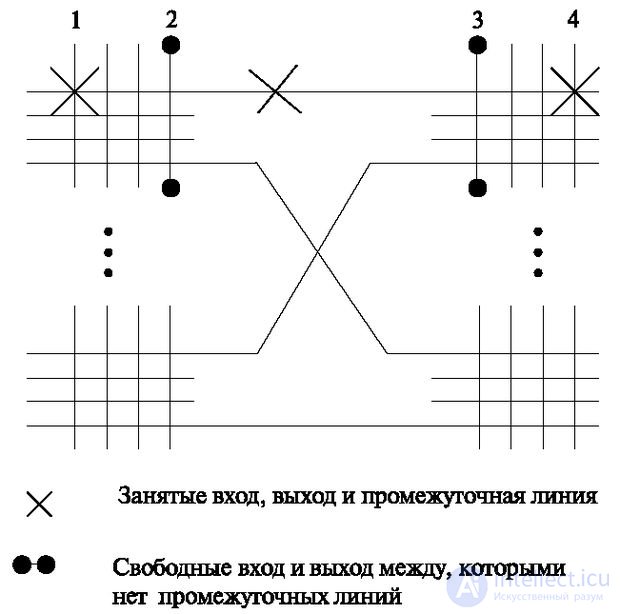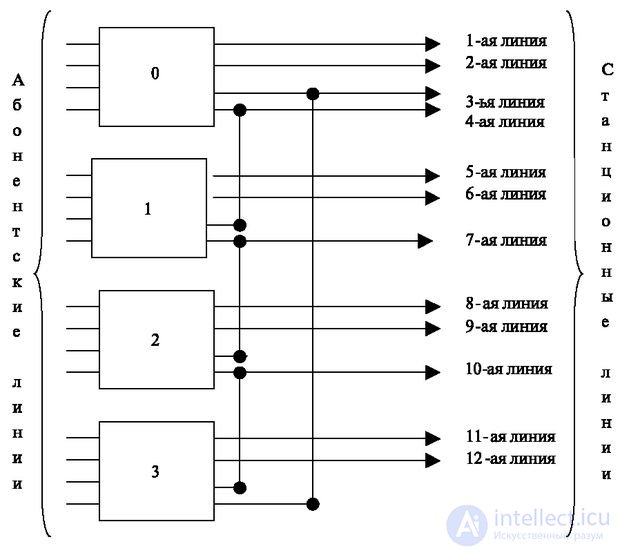Lecture
The transition from single-link switching circuits to multi-link circuits creates a new phenomenon - blocking.
Under the block means the impossibility of establishing a connection from a given input to a free output due to the lack of free intermediate lines.
As an example of blocking (Fig. 1.6), it is shown how it is impossible to establish a connection between the 2nd input and the 3rd output, since the matrix of the two links is connected by a single intermediate line. It is occupied by the connection between input 1 and output 4. This can lead to a connection failure. Therefore, the parameters of two-link switching circuits are calculated for specified losses (this is one of the objectives of the discipline "Teletraffic Theory"). Losses can be reduced by increasing the number of lines between the matrices (i.e., increasing the "connectivity"). In digital stations, intermediate lines represent PCM paths and contain 30 channels, which is equivalent to connectivity f = 30. Increasing connectivity reduces the likelihood of blocking, but still this probability remains and depends on the ratio of the number of inputs and outputs of the intermediate lines, as well as on the number of calls and their duration.

For schemes with any number of links that have interlocks, the conditioned search method is applied. In such schemes, a free line on one link does not mean a free path as a whole due to blocking (as shown in Fig. 1.6). Therefore, the choice of each free line is determined by the freedom of the path as a whole. In the case of a conditioned search, the search for paths occurs in two stages.
The process of identifying and selecting a free line (subscriber, interconnecting and intermediate lines) is often called “sample”, and the device performing this process is called a “test device”.
In addition, another problem arises in connection with blocking - accessibility and mixing of paths.
Accessibility is the number of paths (each of which may consist of several lines) leading from one entrance to the desired exits.
To clarify this concept, consider the possible search options from input to output. The search is classified as:
Mixing is a method of ensuring high availability of subscriber lines to inter-station routes.
Consider rice. 1.6. When searching for any of the outputs of the two-tier scheme, the accessibility from the input belonging to the first switching matrix to the inputs with a free search is equal to the number of its outputs, i.e. m.
In a group search, accessibility depends on the inclusion of lines leading to other stations in the outputs of link B. If all such lines are included in one matrix of link B, then accessibility to the direction to this station is 1 (one line leads to them).
With the inclusion of lines of this direction in different matrices and with a sufficient number of them, accessibility can reach a maximum value of m, a further increase in this indicator is limited by the number of intermediate lines.
With a forced search, availability will be the lowest - it is equal to 1.
Thus, after concentration of the load, all subscriber lines should be provided with access to a smaller number of in-station lines.
Also should be included a scheme that increases the availability of in-station lines to inter-office routes. In fig. 1.7 shows an example of the introduction of a two-stage mixing stage. It is possible to use more steps (for example, up to 4).

In connection with the problem of the availability of lines, it is also necessary to consider, at least theoretically, the so-called incomplete inclusions, when not every output is available to each input. This principle of inclusion was widely applied in the systems of the first generation, and there are no guarantees that it will not be applied again at the new stage of technical progress.
In this example of incomplete switching on of station lines (Fig. 1.8), subscriber lines included in each of the matrices can be connected only to a specific group of station lines. For example, subscriber lines included in the 0th matrix can use the 1st and 2nd station lines, the 3rd line together with the 3rd matrix, and the 4th line - with the 1st matrix.
Such a connection leads to uneven use of station lines. It is usually used with uneven availability of station lines. For example, if the control device selects the matrix outputs starting from a smaller number, the last outputs will be occupied last. The probability of their employment will be less than that of other exits, so they can be placed at the disposal of several groups of subscriber lines.

The individual method is based on the fact that the task of managing the connection is divided into a series of successive tasks, each of which is performed sequentially by a separate device. Most often they are spaced apart and represent the equipment of various stations. Therefore, for the "communication" of such devices requires an alarm.
The most common distribution of tasks is as follows. All tasks of interaction with the subscriber set were assigned to one step (user search level - AI or linear search - LI). On the outgoing connection, this stage received the signal that initiated the connection, transmitted acoustic signals from the station (for example, "station response") and established communication with the next stage. With incoming communication, its task was to determine the state of the subscriber, depending on the result of the determination, acoustic signals were connected and a signal was provided via the network to establish the connection and the subscriber's response.
The next stage (group search stage) received numbers and selected lines in the direction of other stations. To create large networks used several group stages.

The general view of the step control (Fig. 1.9) shows one control device per step. However, there are systems in which each switchgear or group of devices is provided with a control device (Fig. 1.10).

This control method was used in the first automatic stations. Today, it is partially introduced in modern PBXs, when, in the presence of modern digital switches, an individual device is installed to search for free paths and establish a connection in series. It should be noted that the first automatic systems had only one task: establishing a connection. In this sense, modern self-searching systems are similar to them. However, modern stations perform a large number of tasks that are not directly related to the control of the switching field. These tasks are usually performed by other devices separated from the switching field.
Modern routers also provide step control, despite their territorial separation. They are sequential, individually controlled devices.
Comments
To leave a comment
Telecommunication Services and Devices
Terms: Telecommunication Services and Devices